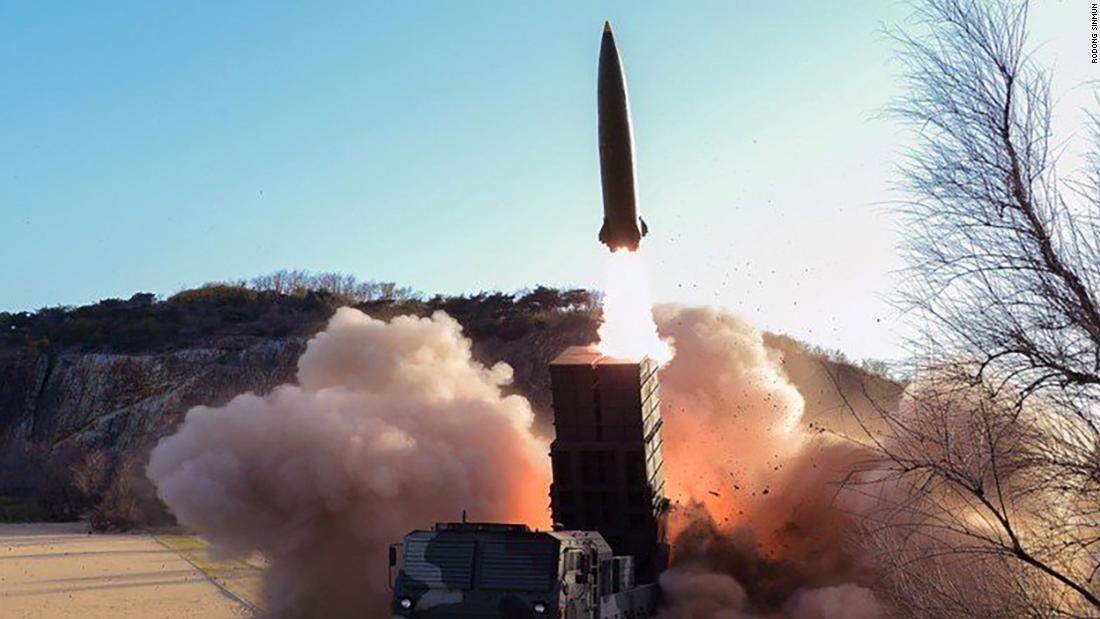Images published Sunday by North Korea state-owned newspaper Rodong Sinmun showed the country’s leader, Kim Jong Un, smiling and clapping as he observed the test-firing of what the newspaper called a “new tactical weapon.”
The projectiles were fired from North Korea’s Hamhung area around 6 p.m., South Korea’s Joint Chiefs of Staff said in a statement on Sunday. The projectiles flew about 110 kilometers (about 68.3 miles) at an altitude of 25 kilometers (15.5 miles), with a maximum speed of Mach 4.0 or lower, said the statement.
On Sunday, North Korean state media KCNA reported Kim had observed the test firing of a “new-type tactical guided weapon,” which was “carried out successfully.”
KCNA claimed the new weapon boosted the country’s “frontline long-range artillery units,” and increased efficiency “in the operation of tactical nukes of (North Korea) and diversification of their firepower missions.”
Immediately after the launch, South Korea’s military, intelligence agencies and National Security Office held an emergency meeting to assess the situation and discuss countermeasures, according to the Joint Chiefs of Staff statement.
South Korean President Moon Jae-in is receiving real-time reports from the National Security Office, and has ordered the relevant government ministries to inspect North Korea’s movements, Moon’s spokeswoman Park Kyung-mee said in a statement Sunday.
“We are aware of the North Korean statement that they conducted a test of a long range artillery system. We analyze all activities in close coordination with our allies and partners,” said a spokesperson for the US Department of Defense in a statement, adding that the US is “very clear on our commitment to the defense of (South Korea), Japan, and the US homeland.”
Duyeon Kim, an Adjunct Senior Fellow at the Center for a New American Security, said North Korea had been aiming to make missiles that can evade defense systems, with “features that can fly them under the US and South Korea’s radars.”
“These types of missiles are especially threatening to South Korea and Japan and they’re weapons that can be used in or even start a conflict,” she said.
Ankit Panda, Stanton Senior Fellow at the Carnegie Endowment for International Peace, added that this was the first time North Korea has “specifically ascribed a tactical nuclear weapons’ role for a missile at a test.”
North Korea has increased its missile tests this year, including its first intercontinental ballistic missile (ICBM) in more than four years on March 24, in defiance of international law.
In just the first four months of 2022, the North has conducted 12 tests; by comparison, it only conducted four tests in 2020, and eight in 2021.
Duyeon Kim said the tests could have several purposes: one being a message to the North Korean people that “their country is strong despite their apparent economic difficulties.”
North Korea also has “a domestic imperative to make and perfect the types of advanced weapons that Kim Jong Un ordered last year,” she said. This year is an important one for the country because of several major dates — including the 10-year anniversary of Kim Jong Un’s rule and the 110th anniversary of the birth of its founder Kim Il Sung — one of the most important events in the North Korean calendar.
Lee Sang-hyun, president of the South Korean think tank Sejong Institute, said Kim may be under pressure “to show off his achievements.” April holds many of those important dates, providing an opportunity “to show off to the world about their country’s missile and nuclear capabilities.”
Another reason for the recent tests could be to protest the US-South Korea joint military drills set to take place this month, experts said.
North Korea has long condemned these joint drills as posing a grave threat to its security, accusing the US of a “hostile policy” toward the country.

